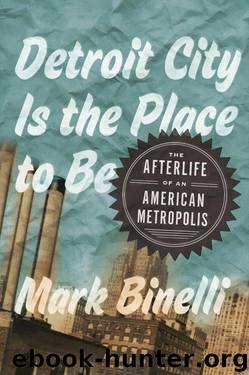Detroit City Is the Place to Be: The Afterlife of an American Metropolis by Mark Binelli

Author:Mark Binelli [Binelli, Mark]
Language: eng
Format: epub, mobi
Tags: cookie429, Kat, Extratorrents
ISBN: 9780805092295
Amazon: 0805092293
Publisher: Metropolitan Books
Published: 2012-11-13T00:00:00+00:00
Abandoned Highland Park police station. [Yves Marchand and Romain Meffre]
9
AUSTERITY 101
NO MATTER HOW DEXTROUS or well-intentioned our elected officials, any plan to reinvent Detroit, or even adequately address the city’s most fundamental crises, required the one thing Detroit lacked most of all: unimaginable amounts of money. As John Mogk, the Wayne State law professor and urbanist, pointed out, Detroit’s major recent success stories have been obtained in large part through spectacular levels of capital investment. “If you reach back to the sixties,” he said, the housing development of Lafayette Park “has probably experienced a billion dollars a mile in public and private investment. Midtown”—which includes the university and hospital districts—“in the two miles from the Fox Theater to Grand Boulevard, has probably experienced a billion a mile over the past ten years.”
Mogk contrasted this healthy area of Detroit, which he calls the Core, with the other 130 square miles of the city, which he calls the Heartland—historically the strength of Detroit, a city never known for its downtown as much as for its industrial plants, strong neighborhoods, and high levels of home ownership. The Heartland, Mogk noted, has been steadily deteriorating. “And that’s where all the problems are,” he says. “And the only part of that whole area that’s received anything commensurate with the level of investment in the Core area has been the Poletown Plant and the Chrysler Jefferson Plant. So, as Core Detroit becomes more closely linked with the suburbs, Heartland Detroit is drifting off on its own. To focus on what’s happening in the Core area really creates a false sense of future hope. If you look at the income distribution in the city and ask me if the Heartland is coming back, well, are you kidding me? Cities are not built or rebuilt for low-income residents. It would be nice if they were. But that just doesn’t happen.”
As municipalities across the globe stare down varying levels of financial catastrophe, the notion of increasing investment in failing communities such as the Mogk-defined Heartland has become folly, with the terms of debate instead shifting almost entirely to discussions of debt reduction and austerity. The received, morality-tale version of the salvation of the auto industry, often recounted in the form of a self-help recovery narrative, in which the mulish executive-suite occupants were forced to hit rock bottom before making the “hard choices” necessary for survival, has more recently been applied to ever more insolvent governmental entities, which have been painted as the functional and moral equivalents of GM or Chrysler, that is, bloated and inefficient bureaucracies unwilling to change with the times, get tough on labor, and become “lean” and “competitive.” Like the Big Three, we were all being told that our cities and states—along with their citizens and public servants—needed to discard childish illusion and accept that aspects of American life had changed forever.
In this context, the Michigan legislature adopted the Emergency Financial Manager law, which deficit hawks cast as a top-down, stern-father means of enforced frugality, necessary for irresponsible charges who had proved incapable of making, and abiding by, a budget.
Download
Detroit City Is the Place to Be: The Afterlife of an American Metropolis by Mark Binelli.mobi
This site does not store any files on its server. We only index and link to content provided by other sites. Please contact the content providers to delete copyright contents if any and email us, we'll remove relevant links or contents immediately.
The Secret History by Donna Tartt(16623)
The Social Justice Warrior Handbook by Lisa De Pasquale(11489)
Thirteen Reasons Why by Jay Asher(7788)
This Is How You Lose Her by Junot Diaz(5771)
Weapons of Math Destruction by Cathy O'Neil(5036)
Zero to One by Peter Thiel(4824)
The Myth of the Strong Leader by Archie Brown(4789)
Promise Me, Dad by Joe Biden(4447)
Beartown by Fredrik Backman(4417)
Stone's Rules by Roger Stone(4415)
How Democracies Die by Steven Levitsky & Daniel Ziblatt(4398)
The Fire Next Time by James Baldwin(4342)
100 Deadly Skills by Clint Emerson(4076)
A Higher Loyalty: Truth, Lies, and Leadership by James Comey(4032)
Rise and Kill First by Ronen Bergman(4012)
The David Icke Guide to the Global Conspiracy (and how to end it) by David Icke(3881)
The Farm by Tom Rob Smith(3872)
Secrecy World by Jake Bernstein(3782)
The Doomsday Machine by Daniel Ellsberg(3730)
